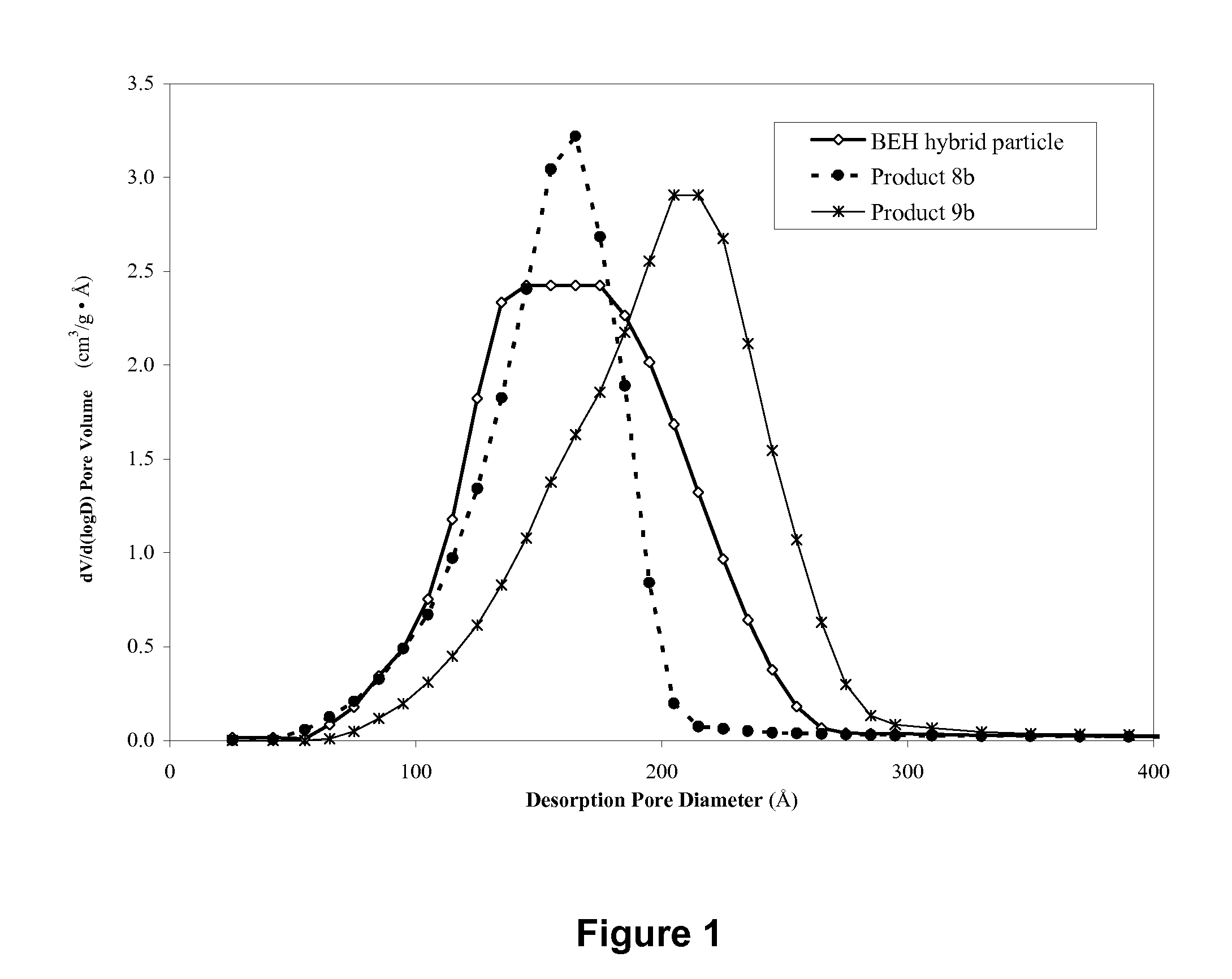Hybrid inorganic/organic materials having novel surface modification; process for the preparation of inorganic/organic hybrid materials; and use of said particles for chromatographic separations
a technology hybrid materials, which is applied in the field of hybrid inorganic/organic materials having novel surface modification, can solve the problems of low efficiency, shrinkage and swelling of organic chromatographic materials, and lack of mechanical strength of typical chromatographic silicas, etc., and achieve enhanced chromatographic separation and one or more characteristics.
- Summary
- Abstract
- Description
- Claims
- Application Information
AI Technical Summary
Benefits of technology
Problems solved by technology
Method used
Image
Examples
example 1
Synthesis of Polyorganosiloxanes
[0408]One or more tetraalkoxysilanes or organoalkoxysilanes (all from Gelest Inc., Morrisville, Pa. or United Chemical Technologies, INC., Bristol, Pa.) or zirconium n-propoxide (70% in propanol, Gelest Inc., Morrisville, Pa., 172.5 g solution used in reaction 1n) were mixed with ethanol (anhydrous, J.T. Baker, Phillipsburgh, N.J.) and an aqueous hydrochloric acid solution (Aldrich, Milwaukee, Wis.) in a flask. Reactions 1a-1r, 1u-1y used 0.1 N HCl, reactions 1s and 1t used 0.01 N HCl, reaction 1z used 0.1 M acetic acid (J.T. Baker). Hydroquinone (Aldrich, Milwaukee, Wis.) was also added to reaction 1o (8.4 mg) and reaction 1p (17.6 mg) to prevent polymerization of the methacryloxypropyl groups. Product 1y was prepared following a literature protocol (as described in K. Unger, et. Al. Colloid &Polymer Science vol. 253 pp. 658-664 (1975)). The resulting solution was agitated and refluxed for 16 hours in an atmosphere of argon or nitrogen. Alcohol was r...
example 2
Hybrid Inorganic / Organic material surrounding of Hybrid Particles
[0409]To a suspension of 5 μm BEH porous hybrid particles (20 g, Waters Corporation, Milford, Mass.; 6.5% C; SSA=190 m2 / g; SPV=0.80 cm3 / g; APD=155 Å) of the formula (O1.5SiCH2CH2SiO1.5)(SiO2)4 (prepared following the method described in U.S. Pat. No. 6,686,035) in ethanol (anhydrous, J.T.Baker, Phillipsburgh, N.J.; 5 mL / g) was added POS 1a from Example 1. The solvent was slowly removed under reduced pressure in a rotary evaporator for 0.5-4 hours. The particles were isolated on 0.5 μm filtration paper and washed repeatedly using ethanol (anhydrous, J.T.Baker, Phillipsburgh, N.J.). The material was then heated 50° C. in a suspension with ethanol (3 mL / g, anhydrous, J.T.Baker, Phillipsburgh, N.J.), deionized water (7 mL / g) and 30% ammonium hydroxide (20 g; J.T. Baker, Phillipsburgh, N.J.) for 20 hours. The reaction was then cooled and the product was filtered and washed successively with water and methanol (J.T. Baker, P...
example 3
Hybrid Inorganic / Organic Material Surrounding of Hybrid Particles
[0410]To a suspension of 5 μm BEH porous hybrid particles (20 g, Waters Corporation, Milford, Mass.; 6.5% C; SSA=190 m2 / g; SPV=0.80 cm3 / g; APD=155 Å) of the formula (O1.5SiCH2CH2SiO1.5)(SiO2)4 (prepared following the method described in U.S. Pat. No. 6,686,035) in dry toluene (Fisher Scientific, Fairlawn, N.J.; 5 mL / g) was added POS 1a from Example 1 and water. This reaction was heated at 80° C. for one hour and 110° C. for 20 hours using a Dean-Stark trap to remove residual water. The reaction was cooled to room temperature and particles were isolated on 0.5 μm filtration paper and washed repeatedly using ethanol (anhydrous, J.T.Baker, Phillipsburgh, N.J.). The material was then heated to 50° C. in a suspension with ethanol (3 mL / g, anhydrous, J.T.Baker, Phillipsburgh, N.J.), deionized water (7 mL / g) and 30% ammonium hydroxide (20 g; J.T.Baker, Phillipsburgh, N.J.) for 4 hours. The reaction was then cooled and the pro...
PUM
| Property | Measurement | Unit |
|---|---|---|
| mol % | aaaaa | aaaaa |
| organic | aaaaa | aaaaa |
| inorganic/organic | aaaaa | aaaaa |
Abstract
Description
Claims
Application Information
 Login to View More
Login to View More - R&D
- Intellectual Property
- Life Sciences
- Materials
- Tech Scout
- Unparalleled Data Quality
- Higher Quality Content
- 60% Fewer Hallucinations
Browse by: Latest US Patents, China's latest patents, Technical Efficacy Thesaurus, Application Domain, Technology Topic, Popular Technical Reports.
© 2025 PatSnap. All rights reserved.Legal|Privacy policy|Modern Slavery Act Transparency Statement|Sitemap|About US| Contact US: help@patsnap.com



